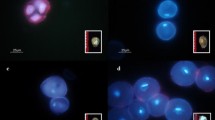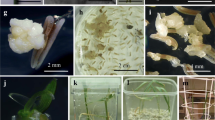Abstract
The pollen development and androgenic ability of 18 kale (Brassica oleracea convar.acephala) genotypes was observed during an anther culture study. Anther culture was successful in 6 of the genotypes and the highest yield obtained was 17 embryos per 100 anthers plated. Two stages of anther development were identified as being responsive to anther culture. The first and most responsive was that corresponding to the late uninucleated stage and the second to the late binucleated stage. These stages correspond with the onset of mitotic events in the microspores. Pollen viability was studied and low viability was noted which declined to zero after 9 days of anther culture. The initial viability level however was not clearly related to androgenic ability. The significance of the production of haploid and dihaploid kale genotypes in the study and breeding of resistance to clubroot is discussed.
Similar content being viewed by others
References
Arnison PG, Donaldson P, Jackson A, Semple C & Keller WA (1990a) Genotype-specific response of cultured broccoli (Brassica oleracea var.italica) anthers to cytokinins. Plant Cell Tiss. Org. Cult. 20: 217–222
Arnison PG, Donaldson P, Ho LC & Keller WA (1990b) The influence of various physical parameters on anther culture of broccoli (Brassica oleracea var.italica). Plant Cell Tiss. Org. Cult. 20: 147–155
Arnison PG & Keller WA (1990) A survey of anther culture response ofBrassica oleracea L. cultivars grown under field conditions. Plant Breeding 104: 125–133
Biddington NL & Robinson HT (1990) Variation in response to high temperature treatments in anther culture of Brussels sprouts. Plant Cell Tiss. Org. Cult. 22: 48–54
Cao MO, Charlot F & Dore C (1990) Embryogenèse et régénération de plantes de chou à choucroute (Brassica oleracea L. sppcapitata) par culturein vitro de microspores isolées. C.R. Acad. Sci. Paris, t. 310, SérieIII: 203–209
Couteau N (1990) Analyse du déterminisme génétique de la résistance à la hernie (Plasmodiophora brassicae) à partir de trois populations deBrassica oleracea. Mémoire de D.E.A., E.N.S.A. Rennes, Université de Rennes J (51 p.)
Deslauriers C, Powell AD, Fuchs K & Pauls KP (1991) Flow cytometric characterization and sorting of culturedBrassica napus microspores. Biochimica et Biophysica Acta 1091: 165–172
Fuller MP & Turton S (1990) Anther culture of winter-heading cauliflower. Acta Hort. 280: 329–331
Heslop-Harrison J & Helsop-Harrison Y (1970) Evaluation of pollen viability by enzymatically induced fluorescence; intracellular hydrolysis of fluorescein diacetate. Stain Technol. 45: 115–120
Jones DR, Ingram DS & Dixon GR (1981) Differential pathogenicity ofPlasmodiophora brassicae. Cruciferae Newsletter 6: 54–56
Keller WA & Armstrong KC (1977) Embryogenesis and plant regeneration inBrassica napus anther cultures. Can. J. Bot. 55: 1383–1388
Keller WA & Armstrong KC (1981) Production of anther-derived dihaploid plants in autotetraploid marrowstem kale (Brassica oleracea var.acephala). Can. J. Genet. Cytol. 23: 259–265
Kott LS, Polsoni L & Beversdorf WD (1988) Cytological aspects of isolated microspore culture ofBrassica napus. Can J. Bot. 66: 1658–1664
Messiaen CM, Blancard D, Rouxel F & Lafon R (1991) Les maladies des plantes maraîchères. Ed I.N.R.A. Paris (552 P.)
Monteiro AA & Williams PH (1989) The exploration of genetic resources of portuguese cabbage and kale for resistance to severalBrassica diseases. Euphytica 41: 215–225
Ockendon DJ (1983) Use of anther culture in Brussels sprouts breeding. Cruciferae Newsletter 8: 58–60
Orton TJ & Browers MA (1985) Segregation of genetic markers among plans regenerated from cultured anthers of broccoli (Brassica oleracea var.italica). Theor. Appl. Genet. 69: 637–643
Scott R, Dagless E, Hodge R, Pyatt P, Soufleri I & Draper J (1991) Patterns of gene expression in developing anthers ofBrassica napus. Plant. Mol. Biol. 17: 195–207
Thomas G, Baron F, Rouxel F, Sanson MT & le Jeune B (1991) Etat actuel des connaissances sur la hernie du chou-fleur en Bretagne. Aujourd'hui et Demain 31: 20–25
Thurling N & Chay PM (1984) The influence of donor plant genotype and environment on production of multicellular microspores in cultured anthers ofBrassica napus ssp.oleifera. Ann. Bot. 57: 681–683
Vergne P, Delvallee I & Dumas C (1987) Rapid assessment of microspore and pollen development stage in wheat and maize using DAPI and membrane permeabilization. Stain Technol. 62: 299–304
Yang Q, Chauvin JE & Herve Y (1992) A study of factors affecting anther culture of cauliflower (Brassica oleracea var.botrytis). Plant Cell Tiss. Org. Cult. 28: 289–296
Zaki MAM & Dickinson HG (1990) Structural changes during the first divisions of embryos resulting from anther and free microspore culture inBrassica napus. Protoplasma 156: 149–162
Author information
Authors and Affiliations
Rights and permissions
About this article
Cite this article
Kieffer, M., Fuller, M.P., Chauvin, JE. et al. Anther culture of kale (Brassica oleracea L. convar.acephala (DC.) Alef.). Plant Cell Tiss Organ Cult 33, 303–313 (1993). https://doi.org/10.1007/BF02319016
Received:
Accepted:
Issue Date:
DOI: https://doi.org/10.1007/BF02319016




